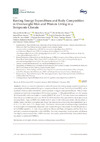Identificador persistente para citar o vincular este elemento:
https://accedacris.ulpgc.es/jspui/handle/10553/71096
| Título: | Resting energy expenditure and body composition in overweight men and women living in a temperate climate | Autores/as: | Martín Rincón, Marcos Pérez Valera, Mario Morales Álamo, David Perez Suárez,Ismael Dorado García, Cecilia González Henríquez, Juan José Juan-Habib, Julian W. Quintana-Garcia, Cristian Galvan Alvarez, Victor Pedrianes Martín, Pablo Benito Acosta, Carmen Curtelin Pérez,David López Calbet, José Antonio De Pablos Velasco, Pedro Luis |
Clasificación UNESCO: | 241106 Fisiología del ejercicio 320606 Necesidades alimenticias |
Palabras clave: | Exercise Obesity Overweight Resting energy expenditure Basal Metabolic-Rate, et al. |
Fecha de publicación: | 2020 | Proyectos: | Integracion de Los Grupos de la Obesidad y El Síndrome Metabólico .... Viabilidad y Sostenibilidad Del Adelgazamiento Mediante Tratamiento Intensificado en Pacientes Con Sobrepeso U Obesidad: Mecanismos Neuroendocrinos y Moleculares Estudio longitudinal de los efectos de una modificación intensiva del estilo de vida en la composición corporal e indicadores bioquímicos y moleculares de salud en pacientes con sobrepeso y obesidad: aplicación para la evaluación fisiológica de rutas y sistemas de monitorización del esfuerzo ... |
Publicación seriada: | Journal of Clinical Medicine | Resumen: | This study aimed to determine whether the measured resting energy expenditure (REE) in overweight and obese patients living in a temperate climate is lower than the predicted REE; and to ascertain which equation should be used in patients living in a temperate climate. REE (indirect calorimetry) and body composition (DXA) were measured in 174 patients (88 men and 86 women; 20-68 years old) with overweight or obesity (BMI 27-45 kg m-2). All volunteers were residents in Gran Canaria (monthly temperatures: 18-24 °C). REE was lower than predicted by most equations in our population. Age and BMI were similar in both sexes. In the whole population, the equations of Mifflin, Henry and Rees, Livingston and Owen, had similar levels of accuracy (non-significant bias of 0.7%, 1.1%, 0.6%, and -2.2%, respectively). The best equation to predict resting energy expenditure in overweight and moderately obese men and women living in a temperate climate all year round is the Mifflin equation. In men, the equations by Henry and Rees, Livingston, and by Owen had predictive accuracies comparable to that of Mifflin. The body composition-based equation of Johnston was slightly more accurate than Mifflin's in men. In women, none of the body composition-based equations outperformed Mifflin's. | URI: | https://accedacris.ulpgc.es/handle/10553/71096 | ISSN: | 2077-0383 | DOI: | 10.3390/jcm9010203 | Fuente: | Journal of Clinical Medicine [ISSN 2077-0383], v. 9 (1), 203, (Enero 2020) |
| Colección: | Artículos |
Citas SCOPUSTM
6
actualizado el 08-jun-2025
Citas de WEB OF SCIENCETM
Citations
6
actualizado el 08-jun-2025
Visitas
249
actualizado el 23-nov-2024
Descargas
259
actualizado el 23-nov-2024
Google ScholarTM
Verifica
Altmetric
Comparte
Exporta metadatos
Los elementos en ULPGC accedaCRIS están protegidos por derechos de autor con todos los derechos reservados, a menos que se indique lo contrario.
